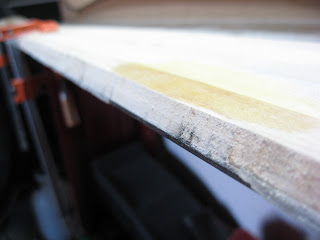I designed my first ski press in early 2009; I was a mechanical engineer less than a year out of college. I could not afford to build a press out of steel and determined that a press made from wood, if designed properly, would operate just fine and would by 1/10th the cost. The design of my first ski press is outlined below.
The ski press is used to react the pressure from the air bladder when it presses the ski into shape on the mold. For example, the press is 10 inches wide by 84 inches long. At 25 psi, this is a total force of 10in x 84in x 25 lb/in^2 =21,000 lb or 10.5 tons of force. This is a significant amount of force to react, but illustrates the power and usefulness of an air bladder.
The air bladder is made from 6" diameter marine discharge hose rated for 70psi. The ends are bolted closed with angle iron and are sealed with silicone caulking. A pass-through-wall valve was used to attache the air hose.
I designed the press to work at 30 psi and pressure tested it. I used it to press my first two skis and it worked well. I then pressurized it for the third ski. After pressurizing to 30 psi, I looked up and notice the second brace back from the front had cracked left of center and was bowing outward. The press was stable, but I decided I should decrease the pressure and try to save the ski. As soon as I decreased the pressure the brace snapped clean through, causing a chain reaction breaking all but the last two braces.
When I realized what happened I knew the ski was lost as the epoxy hardened it into a shapeless ski. I few seconds later I could feel my mouth getting warmer and filling up with blood. The pressure relief valve was connected to the ski bladder and when I relieved the pressure the front brace broke outward and struck my jaw. My teeth went into the side of my cheek and I ended up needing two stitches in my mouth. I did have safety glasses on and eventually noticed bruising on the bridge of my nose where the glasses protected my eyes.
RECOVERY
I share this story so that the people can learn from my mistakes. There were several things wrong with my press which I corrected.
- The cause of failure was a stress concentration in the second brace. I had drilled a hole through the cross brace (see part 10 above) so that a bolt could pass through and suspend the platform (Part 3). The stress around this hole was approximately 3X higher than in the rest of the brace. This location fatigued after three uses and cracked on the fourth. To correct this problem I used metal straps to connect the cross braces to the platform.
- The platform (Part 3) as shown in the image above was free to bow as the pressure increased. Therefore the cross brace was in full bending, maximizing the stress. To correct this problem I attached plywood to the top of the platform
- The pressure gages and relief valve was attached to the bladder. I moved this to the other end of the hose for future pressing to keep my body away from the press in the event of a failure.
In addition to the items noted above I redesigned the press for a much higher safety factor and took pure bending into consideration in my calculations. I added two additional braces to the press and made the braces from 2x6 lumber in lieu of 2x4 lumber. The calculations I did are shown below:
To rebuild the press I salvaged what I could from the wreckage and started over.
The finished press:
Comparison of the old press bracing size to the new brace.
I managed to salvage the core of the ski by tearing of the base and the top sheet and then sanding any remaining epoxy and the graphics layer away.
The redesigned press has worked now for 16 presses and 3 pressure tests and shows no signs of fatigue. To prevent such a failure again I inspect the press for cracks prior to every use. There were some cracks that existed in the wood at the initial build, but those cracks have not propagated no significant cracks have been noted since it was designed. I also pressure test the press prior to a round of pressing to ensure the press is in good shape as well as the air bladder. Additionally, I put on my face shield prior to pressurizing the press after which my adrenaline always starts pumping.
A final note, whether or not you are an engineer, take care in the design of your ski press and always build redundancies into the system; if you don't know what you're doing, then get someone who does to review your work.


































